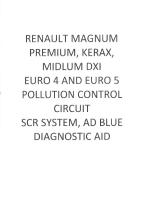GDC System Backup and Recovery
December 30, 2010 System recovery on the GDC server Introduction This document introduces a new system recovery feature
Views 165 Downloads 9 File size 1MB
Recommend stories
- Author / Uploaded
- guerrero
Citation preview
December 30, 2010
System recovery on the GDC server Introduction This document introduces a new system recovery feature for GDC servers. This feature can be enabled with a software update from GDC support. This system recovery feature can be used to recover from the following errors: • •
Corrupted OS filesystem requiring filesystem checking Errors in the OS partition which requires re-installing OS files
Accessing the recovery system The system recovery feature is contained in a separate boot image on the GDC server. Users will have to attach a keyboard to the GDC server before powering on the server, and interrupt the normal boot sequence to boot into the recovery system. The recovery system is designed to be used with a keyboard attached to the server. Note: Normal server operation cannot be carried out while the server is booted into the recovery system.
To exit from the recovery system, select ‘Reboot’ from the recovery system’s main menu (See Figure 2).
GDC Technology Ltd.
Page 1 of 6
December 30, 2010
Booting into the recovery system Follow the steps below to boot into the recovery system: 1. Attach a USB keyboard to the GDC server, using either the USB ports on the front or rear panels. 2. Press the ‘Esc’ key during system boot to access the boot menu. 3. Select the ‘Rescue’ entry and press the ‘Enter’ key to boot into the recovery system (See Figure 1). 4. After the recovery system boots, the menu for the recovery system is displayed (See Figure 2).
Figure 1 GDC server boot menu
Figure 2 Main menu for recovery system
GDC Technology Ltd.
Page 2 of 6
December 30, 2010
System recovery features All features for the recovery system can be accessed through the main menu shown in Figure 2. Users can perform the following actions while the recovery system is active: • • • •
Create a system restore image Restore the system from a system restore image Manage system restore images Perform filesystem repair on an existing system
Note: RAID drives will not be affected by system recovery. If the system is restored from an image, the data on the RAID drives is not affected.
Creating a system restore image Select the first menu item (“Backup OS”) on the recovery system main menu to create a system restore image from the current existing system. Backup progress will be shown while the system is creating the image (see Figure 3). A system restore image will be created in 15 minutes or less.
Figure 3 Creating a system restore image
Note: Creating a system restore image after setting up the server is highly recommended. This will create an image that contains the server’s default settings, which can be recovered when errors are encountered in the future.
GDC Technology Ltd.
Page 3 of 6
December 30, 2010
Restoring from a system restore image Select the second menu item (“Restore OS”) on the recovery system main menu to restore an image to the current system. All data on the current system will be overwritten. Restore progress will be shown while the image is restored (See Figure 4).
Figure 4 Restoring an image
Managing system restore images The third menu item (“Manage OS backups”) on the recovery system main menu allows management of all the system restore images created. System restore images created can be viewed, and unneeded images can be deleted.
Figure 5 System restore image management
A list of the system restore images created is shown when the menu item is selected (See Figure 5). An image can be deleted by selecting the image and hitting ‘Enter’ on the ‘Remove’ button. Select the ‘Back’ button to return to the main menu.
GDC Technology Ltd.
Page 4 of 6
December 30, 2010
Filesystem repair The fourth item (“Repair OS Filesystem”) on the recovery system main menu checks and automatically repairs the OS filesystem. A dialog box is shown during filesystem repair (see Figure 6). The time taken for filesystem repair depends on the amount of repairs required on the filesystem.
Figure 6 OS filesystem repair
If the filesystem repair cannot be completed successfully, an error message will be shown (see Figure 7). It is recommended to restore from a system image if filesystem repair fails.
Figure 7 OS filesystem repair failed
GDC Technology Ltd.
Page 5 of 6
December 30, 2010
Technical support Please use the following contact information for technical support in your region. Americas Help +1 877 743 2872 (Toll Free) Line +1 818 972 4370 Fax +1 877 643 2872 (Toll Free) +1 818 972 4374 Email [email protected]
Europe Help Line
China Help Line Fax Email
South East Asia Help Line +65 6100 4328
+86 400 886 0966 (Toll Free) +86 755 8611 0966 +86 755 8611 0909 [email protected]
Fax Email
Fax Email
+1 877 743 2872 (Toll Free) +1 818 972 4370 +1 877 643 2872 (Toll Free) +1 818 972 4374 [email protected]
+65 6222 1089 [email protected]
North Asia Help +852 3520 0920 Line Email [email protected]
GDC Technology Ltd.
Page 6 of 6




![Practica1 [Backup and Restore]](https://vsip.info/img/200x200/practica1-backup-and-restore-pdf-free.jpg)




